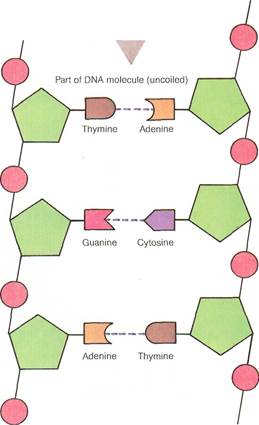
CATEGORIES:
BiologyChemistryConstructionCultureEcologyEconomyElectronicsFinanceGeographyHistoryInformaticsLawMathematicsMechanicsMedicineOtherPedagogyPhilosophyPhysicsPolicyPsychologySociologySportTourism
Many species of fungi,
such as the pin mold growing on a carrot, obtain nutrients by secreting digestive enzymes into the foodstuff in which they are growing. The enzymes break down the large foodstuff molecules into smaller molecules. These are then absorbed by the fungus. In a similar way, human digestive enzymes break down food into small molecules. These can then be absorbed through the wall of the alimentary canal.


|
There are several theories to explain why enzymes are specific and how they operate. They all center on the enzymes' three-dimensional structure. The simplest theory is the "Iock-and-key" hypothesis. It postulates that a substrate molecule (the "key") attaches itself to an active site (the "lock") of an enzyme molecule, forming a temporary complex. The active site has a particular shape. So only a substrate with the complementary shape can attach itself to this site. In the same way, a lock only accepts a key with the right shape. Hence, molecules with different shapes cannot attach to the active site. Also, if the active site is distorted by excessive heat, the molecule itself will no longer fit.
However, some other compounds may be close enough in shape to the substrate to fit into the active site of the enzyme. These alien substrates are not changed through contact with the enzyme. Rather, they compete with the true substrate for active sites. This inhibits the enzyme's activity.
There are two types of inhibition, in competitive inhibition, an alien molecule forms only a temporary bond with an enzyme. In noncompetitive inhibition, an alien inhibitor molecule either permanently blocks an enzyme's active site or affects it by temporarily binding to a site elsewhere on the enzyme. Many inhibitors, particularly of the noncompetitive type, act as poisons. Cyanide, which binds with an enzyme necessary for cellular respiration, is a good example. Cellular respiration is the process by which cells get oxygen.
More complicated theories of enzyme action hold that an enzyme exists in two separate shapes. A nonactive enzyme would then have one shape. When the same enzyme is active, it would have another shape. Some enzymes do not work without the presence of what are called cofactors. Some cofactors participate in the enzyme reaction. Others probably lock into the enzyme away from the active site. They hold the enzyme in the correct position
to receive the substrate.
Enzyme systems
Most enzymes work as part of a chain of reactions during metabolism. The product of one enzyme-induced reaction then becomes the substrate for another. To prevent the wasteful production of unnecessary amounts of a particular substance, the whole reaction sequence is controlled by the slowest step.
Enzymes may consist entirely of protein. Or they may consist of protein linked to a group that helps to maintain the shape of the molecule. The group may also participate in the reaction. Sometimes, such a group fulfills both these functions. Trace metal minerals (such as iron and cobalt) are often necessary in the diet. They are used by these groups. Water-soluble vitamins are often important because they are cofactors in an enzyme system.
Sexual reproductionin
many animals depends on enzymes. When the head of a sperm hits the outer membrane of an egg, a small sac of special enzymes at the front of the sperm's head breaks open. The released enzymes break down the egg's membrane. This allows the sperm to penetrate and fertilize the egg—as shown in the scanning electron micrograph /above!. After the egg has been fertilized, its outer membrane undergoes little-understood changes. These changes make the egg resistant to the enzymes of subsequent sperm. This prevents multiple fertilization.

|

|
| The formation of deoxyribo- Phosphoric acid nucleic acid (DNA) |


DNAis a giant nucleic acid molecule consisting of two nucleotide chains twisted into a double helix (above). The sequence of reactions by which it is formed is shown in the diagram fright). The first stage is the synthesis of individual nucleotides by a condensation reaction between phosphoric acid, the five-carbon sugar deoxyribose, and an organic base. These bases may be thymine, adenine, guanine, or cytosine. Thymine is the example used in the diagram. Water is expelled as a by-product. Many nucleotides then link by further condensation reactions to form a nucleotide chain. Finally, two nucleotide chains link by forming hydrogen bonds (dotted blue lines in the diagram) between their organic bases. This linking produces the twisted, ladderlike DNA molecule.
Nucleotide of DNA fortned by condensation reaction of phosphoric] acid, deoxyribose and organic basej(thyrpine)
■ ■" i
Nucleotides link by condensation reactions to form a chain. Two chaifls then link by hydrogen bonds between the organic) bases to form the double helix of DNA H
Nucleic acids
Nucleic acids are the means by which information about the structure and function of a living organism is stored and passed on to the next generation. Nucleic acids consist of only two types of molecules, deoxyribonucleic acid (DNA) and ribonucleic acid (RNA). They are found in the cells of all living organisms, from viruses to humans.
Date: 2015-12-11; view: 3146
| <== previous page | | | next page ==> |
| Specialized proteins | | | Structures of nucleic acids |